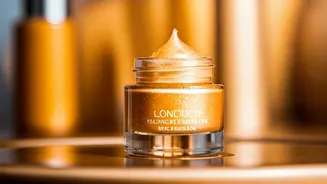Understanding the Problem
Dark circles, a common cosmetic concern, often result from several factors, with genetics and aging playing significant roles. Thinning skin under the
eyes, a natural consequence of aging, can make blood vessels more visible, leading to a darkened appearance. Furthermore, genetics determine skin pigmentation, and those with darker skin tones may be more susceptible to hyperpigmentation in this area. Lifestyle choices also contribute, with sleep deprivation, stress, and excessive alcohol consumption exacerbating the problem. Insufficient sleep allows blood vessels to dilate, causing dark circles. Additionally, fluid retention due to factors like a high-sodium diet or allergies can lead to puffiness, further accentuating the darkness. The combination of these elements makes it critical to address both internal and external factors to achieve the best results. Understanding these underlying causes is the initial step towards designing an effective treatment plan and seeing considerable improvement.
Prioritize Sleep & Rest
Adequate sleep is the cornerstone of any dark circle treatment regimen. Aim for 7-9 hours of quality sleep nightly to allow the body to repair itself and reduce fluid retention. Creating a relaxing bedtime routine can significantly improve sleep quality. This might include taking a warm bath, reading a book, or practicing relaxation techniques like meditation. Position your head slightly elevated with an extra pillow. This can prevent fluid from pooling under the eyes. Sleep deprivation causes blood vessels to dilate, increasing the visibility of dark circles and making eyes appear puffy. Therefore, making sleep a priority is essential. Moreover, maintaining a regular sleep schedule helps regulate the body's natural sleep-wake cycle, ensuring more restful sleep. Consistent sleep promotes overall well-being and reduces the likelihood of dark circles becoming more pronounced.
Hydration & Diet Choices
Maintaining proper hydration is vital. Drink plenty of water throughout the day to flush out toxins and reduce puffiness. Dehydration can make dark circles more prominent, so ensure sufficient fluid intake. In addition to water, consuming hydrating foods like fruits and vegetables contributes to overall hydration. A diet rich in nutrients supports healthy skin and reduces inflammation, which can contribute to dark circles. Reducing sodium intake is equally important, as excessive sodium can lead to fluid retention and under-eye puffiness. Limit processed foods, which tend to be high in sodium. Include foods rich in antioxidants, like berries, spinach, and kale, to protect against free radical damage. By focusing on a balanced diet that promotes hydration and reduces inflammation, you can improve your complexion and minimize the appearance of dark circles.
Effective Skincare Routines
Building a targeted skincare routine can effectively address dark circles and puffy eyes. Start by gently cleansing your face to remove impurities. Consider using a gentle cleanser that won't irritate the sensitive under-eye area. Incorporate products containing ingredients known for their benefits. Products containing Vitamin C can brighten skin and reduce hyperpigmentation. Retinoids, which increase cell turnover, are effective but should be introduced slowly to avoid irritation. Hyaluronic acid is highly effective for hydration and reducing the appearance of fine lines. Application techniques are equally important. When applying eye creams or serums, use a light tapping motion with your ring finger to avoid pulling or stretching the delicate skin. Consistent application, both morning and evening, is crucial for visible results. Choosing the right skincare products and using them correctly is key to improving the appearance of dark circles.
Home Remedies & Compresses
Several home remedies offer quick relief and long-term benefits for dark circles. Cold compresses are effective in reducing puffiness and constricting blood vessels. You can use chilled tea bags (black or green tea), cucumber slices, or cold spoons. These can be applied for 10-15 minutes. The caffeine in tea bags can help reduce swelling. Cucumber slices also provide a cooling effect and are rich in antioxidants. Regularly using these compresses can provide noticeable improvements. Additionally, applying aloe vera gel to the under-eye area can hydrate and reduce inflammation. Aloe vera's soothing properties can offer relief and contribute to overall skin health. These simple home remedies, when incorporated consistently, can greatly contribute to your daily skincare regime, improving the appearance of dark circles.
Medical Treatments & Options
In cases where home remedies are insufficient, medical treatments provide effective alternatives. Professional options include chemical peels, which exfoliate the skin and reduce pigmentation. Laser treatments, like laser resurfacing, can target blood vessels and hyperpigmentation directly, leading to improved outcomes. Dermal fillers, often using hyaluronic acid, can address volume loss and reduce the appearance of dark circles. Injectables smooth the under-eye area. Another approach is light therapy (IPL or Intense Pulsed Light), which can reduce both pigmentation and blood vessel visibility. It's essential to consult a dermatologist or qualified healthcare professional to determine the most appropriate treatment for your specific needs. They can assess your skin type and the underlying causes of your dark circles to recommend the best approach. They will also inform you about potential risks and manage realistic expectations.


